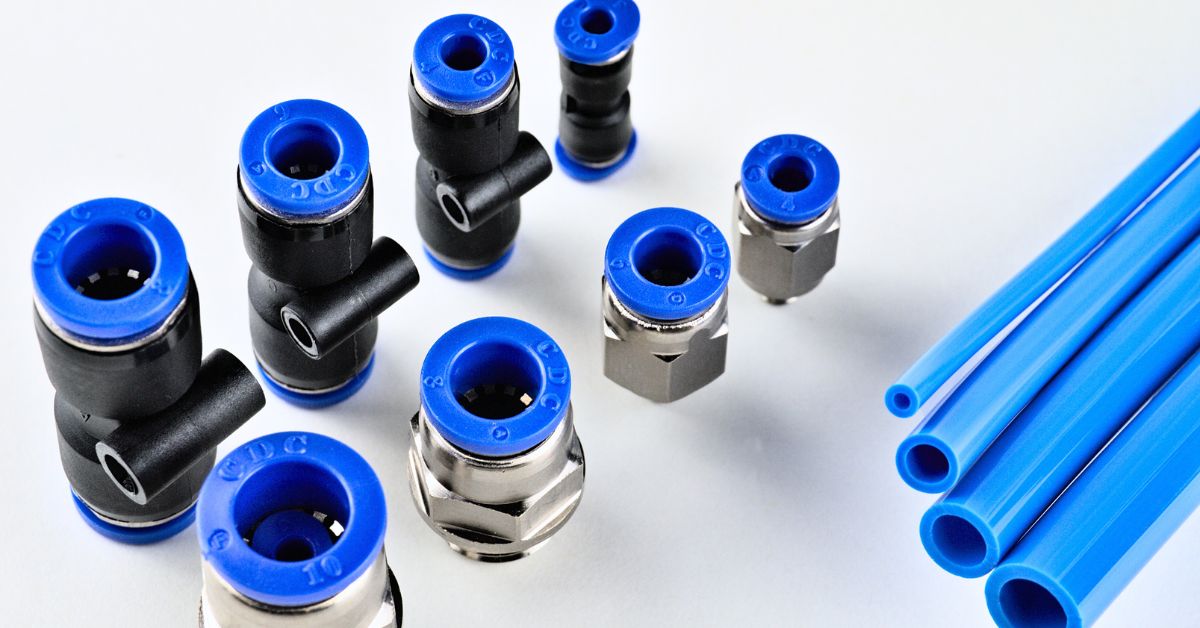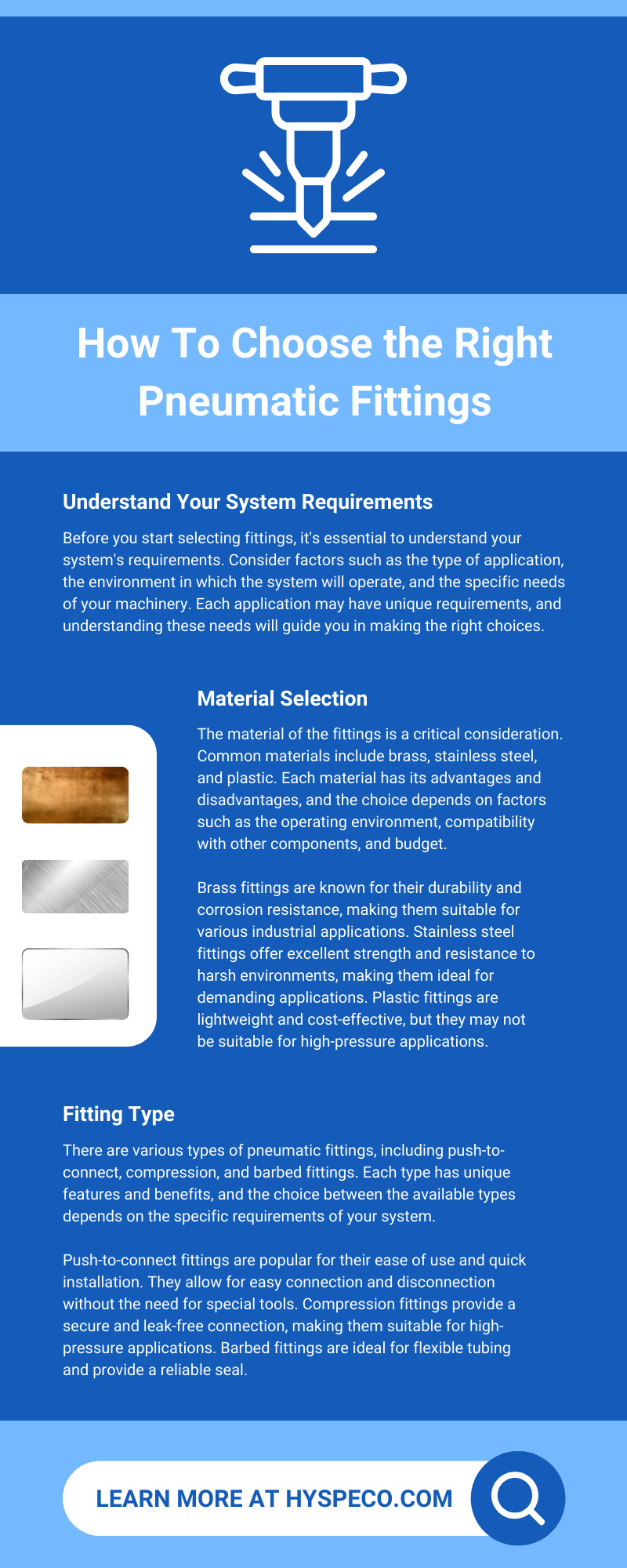How To Choose the Right Pneumatic Fittings

From powering machinery to controlling automation processes, pneumatic systems play a vital role in engineering and manufacturing. However, when it comes to the fittings and various parts for this system, one size does not fit all. You must choose the right pneumatic fittings to ensure the efficiency of your system. Explore what pneumatic systems are, why choosing the right fittings is crucial, and the multiple factors that help you choose the right component.
Understanding Pneumatic Systems
Pneumatic systems use compressed air to transmit and control energy. They are commonly found in various industries, including manufacturing, automation, and aerospace. These systems rely on components such as actuators, valves, and fittings to perform their tasks effectively.
The beauty of pneumatic systems lies in their simplicity and reliability. Unlike hydraulic systems, which use fluid power, pneumatics use air, making them cleaner and less prone to leaks. However, the efficiency of a pneumatic system is heavily dependent on its fittings, which connect different components and enable the flow of compressed air.
Why Choosing the Right Pneumatic Fittings Is Crucial
Choosing the right pneumatic tubing and fittings is crucial for several reasons. First, it ensures the efficient operation of your pneumatic system. The wrong fittings can lead to air leaks, pressure drops, and reduced system performance. This inefficiency can result in increased energy consumption and higher operating costs.
Second, the right fittings enhance the longevity of your system. Poor-quality or incompatible fittings can cause wear and tear on other components, leading to frequent repairs and replacements. By selecting high-quality fittings, you can extend the lifespan of your pneumatic system and reduce downtime.
Finally, choosing the right fittings ensures safety. Pneumatic systems operate under high pressure, and faulty fittings can pose significant safety risks. Properly selected and installed fittings minimize the risk of accidents and help ensure a safe working environment.
How To Choose the Right Pneumatic Fittings
Understand Your System Requirements
Before you start selecting fittings, it's essential to understand your system's requirements. Consider factors such as the type of application, the environment in which the system will operate, and the specific needs of your machinery. Each application may have unique requirements, and understanding these needs will guide you in making the right choices.
For instance, a pneumatic system used in a food processing plant will have different requirements compared to one used in an automated assembly line. Identifying these requirements upfront will help you narrow down your options and choose fittings that are tailored to your application.
Material Selection
The material of the fittings is an important consideration. Common materials include brass, stainless steel, and plastic. Each material has its advantages and drawbacks, and the choice depends on factors such as the operating environment, compatibility with other components, and budget.
Brass fittings are known for their durability and corrosion resistance, making them suitable for various industrial applications. Stainless steel fittings offer excellent strength and resistance to harsh environments, making them ideal for demanding applications. Plastic fittings are lightweight and cost-effective, but they may not be suitable for high-pressure applications.
Fitting Type
There are various types of pneumatic fittings, including push-to-connect, compression, and barbed fittings. Each type has unique features and benefits, and the choice between the available types depends on the specific requirements of your system.
Push-to-connect fittings are popular for their ease of use and quick installation. They allow for easy connection and disconnection without the need for special tools. Compression fittings provide a secure and leak-free connection, making them suitable for high-pressure applications. Barbed fittings are ideal for flexible tubing and provide a reliable seal.
Size and Compatibility
Size and compatibility are crucial factors when selecting pneumatic fittings. Ensure that the fittings you choose are compatible with the tubing and other components in your system. Using fittings that are too large or too small can lead to leaks and reduced system performance.
Measure the outer diameter (OD) and inner diameter (ID) of the tubing to ensure a proper fit. Additionally, check the thread size and type to ensure compatibility with other components. Using mismatched fittings can cause damage to the threads and compromise the integrity of the system.
Pressure and Temperature Ratings
Pneumatic fittings must be able to withstand the pressure and temperature conditions of your system. Check the pressure and temperature ratings of the fittings to ensure they can handle the demands of your application.
Using fittings with inadequate pressure or temperature ratings can lead to failures and pose safety risks. Always choose fittings that meet or exceed the requirements of your system to ensure reliable and safe operation.
Seal Types
The type of seal used in the fittings is another important consideration. Common seal types include O-rings, gaskets, and tapered threads. The choice of seal depends on factors such as the operating pressure, temperature, and the type of fluid used in the system.
O-rings provide a reliable seal and are suitable for a wide range of applications. Gaskets offer excellent sealing capabilities and are ideal for high-pressure applications. Tapered threads create a tight seal through the deformation of the threads and are commonly used in piping systems.
Ease of Installation and Maintenance
Ease of installation and maintenance are important factors to consider when choosing pneumatic fittings. Decide on fittings that are easy to install and require minimal maintenance. This will save you time and effort during the initial setup and ongoing maintenance.
Push-to-connect fittings are known for their ease of installation, while compression fittings provide a secure and reliable connection that requires minimal maintenance. Consider the accessibility of the fittings and the availability of replacement parts when making your selection.
Check for Manufacturer Standards and Certifications
When selecting pneumatic fittings, it's essential to check for manufacturer standards and certifications. Reputable manufacturers adhere to industry standards and certifications to ensure the quality and reliability of their products.
Look for fittings that meet standards such as ISO, ANSI, and SAE. These standards ensure the fittings have been tested and meet specific performance and safety requirements. Choosing fittings from reputable manufacturers with proper certifications will give you peace of mind and ensure the longevity of your pneumatic system.
Understanding how to choose the right pneumatic fittings is crucial for maintaining the efficiency, safety, and longevity of your pneumatic system. Take the time to assess your system's requirements and choose fittings that are tailored to your specific needs. Consider Hyspeco for high-quality fittings that will enable your pneumatic systems to operate at peak efficiency and reliability.


